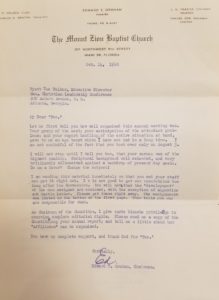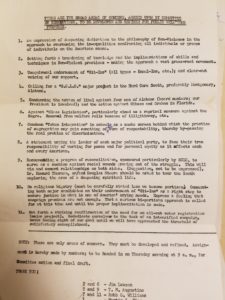(Note: This post was authored by Taylor McNeilly, Processing & Reference Archivist.) This #WyattWalkerWednesday I thought I would discuss some of the more immediately important documents I’ve come across recently while processing the manuscript portion of the Dr. and Mrs. Wyatt Tee Walker Collection, namely the notes from the 1960 annual meeting.
This meeting, held in early August 1960, included a major brainstorm session about the purpose and direction of SCLC. At the time, the organization had no major nonviolent, direct action campaigns under its belt. This would change soon after the annual meeting, perhaps due in part to Dr. Walker’s influence.

A letter from Rev. Edward T. Graham to Rev. Wyatt Tee Walker discussing the annual meeting of August 1960.
The records we have from this annual meeting appear to have been sent by Rev. Edward T. Graham, who was the “Chairman of the Committee” at that time, to Dr. Walker some months later. Rev. Graham’s letter praises Dr. Walker for his work during the meeting, and offers the documents “so that you and your staff can get it right out.” Included is a typed list of resolutions, areas of concern in which SCLC can move forward by planning specific projects to address each one.

List of “areas of broad concern” created at the 1960 annual meeting of SCLC by the Committee on Resolutions.
This list of “areas of broad concern” is deeply foretelling of exactly what the SCLC would do over the coming years, including a dedication to non-violence, as is shown throughout their work; implementation of skills and techniques for non-violent protests, as seen in the training seminars they held for several years to train activists in nonviolent direction action; a major SCLC project in the “Hard Core South,” suggested in Montgomery but eventually held in Birmingham; and a focus on “the need for an all-out voter registration (major project)”, a project that they did in fact undertake.
What was most striking to me, however, was the “unequivocal support of “Sit-Ins” (all types – Kneel-Ins, etc.).” A kneel-in is a type of peaceful protest where black Christians would attend services at a church with an all-white church. But I had never heard the term kneel-in before reading this document, and so my first thought was not of churchgoing but of current political dissent that has been voiced by kneeling, especially that of Colin Kaepernick kneeling during the national anthem. Considering the Nike advertisement published earlier this week, I don’t think this association is surprising. And it does help to draw parallels between the SCLC’s work protesting the injustices of the ’60s and Kaepernick’s work protesting police brutality that disproportionately affects people of color in America today. Both SCLC and Kaepernick focus on nonviolent protest that attempts to capture a wide public audience to bring attention to the “areas of broad concern” being protested.
The materials documenting the 1960 annual meeting are deeply important to the history of SCLC, providing evidence of the beginning of their major push towards nonviolent direction action in the Deep South, voter registration, and training programs for new activists. This documentation also helps clearly define what SCLC stood for, what they supported, and how they viewed themselves as an organization at a time when they were about to become a major actor in national history. But these documents also provide a very real connection to the past that can help guide the present and the future as well.
What are your thoughts on the power of archival collections to connect the past, present, and future? Leave any comments you have below. And as always, please check back next week for another #WyattWalkerWednesday post on the Dr. and Mrs. Wyatt Tee Walker Collection, its processing status, and what interesting finds I uncover as I move through the material.
